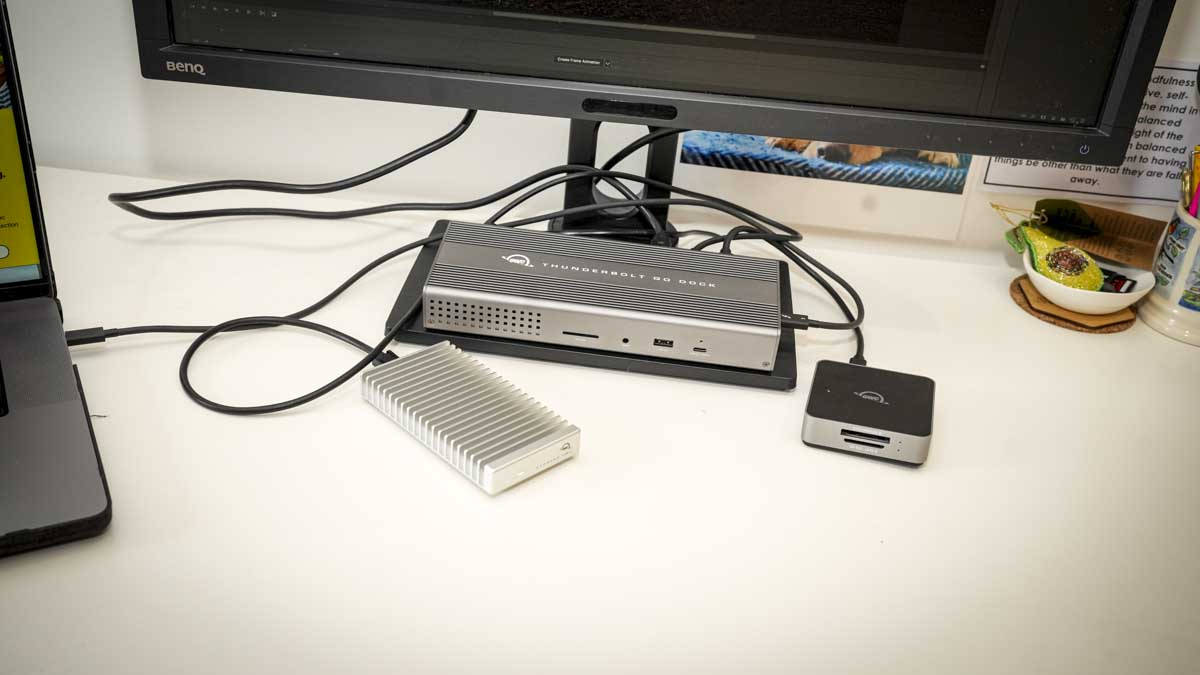TechRadar Verdict
Designed for video and photography professionals on the move, this AC-powered portable docking station packs features and a design that will give you all the convenience and speed of a studio docking station anywhere.
Pros
- +
No separate power adapter required
- +
Supports one 4K 120 Hz monitor or 8K 60Hz monitor
- +
Compatible with OWC software solutions
Cons
- -
Limited to two 4K or 6K monitors
- -
2.5Gb Network Lan
Why you can trust TechRadar
OWC Thunderbolt Go Dock: 30-second review
A first look at the OWC Thunderbolt Go Dock, and you might think that it's just a rather stylish standard under-the-monitor docking station that enables multiple monitor hookups and connections to various accessories. However, OWC is a manufacturer that understands the demands of creative professionals and has designed one of the best laptop docking stations for this purpose - a powerful and robust dock that will withstand the same rigours of use, in-line with professional broadcast and photographic gear, whilst still offering high-performance studio speed and features.
Despite being portable, the OWC Thunderbolt Go Dock requires external AC power from a mains-style socket, either through a standard wall socket or portable power station. Unlike other docks of this type, it has a built-in power adapter to ensure ease and portability. This means setting up and moving on only requires disconnecting one single power cable of the C7 type, Figure of 8 or shotgun connector, which is common for many electrical devices.
The dock itself is relatively simple. Ports along the front enable easy connection of memory cards, USB and audio accessories. At the back of the dock, there are two Thunderbolt 4, two standard USB Type-A, an ethernet and an HDMI port.
OWC is known for its close ties to Apple hardware, and again, here, for Mac users, it's a simple plug-and-play approach. Windows and Linux users will require some additional drivers to use the dock to its full potential. For Windows and Mac iOS systems, however, it includes support for OWC's range of powerful applications, including Innergize, which helps maintain the health of your memory cards, and OWC Dock Ejector, which enables you to disconnect all devices and accessories from the dock with one simple click.
While the features and the transfer speeds between connected devices are incredibly fast due to the Thunderbolt 4 connection, it's a shame that the monitor connection is limited to two 4K or 6K displays at 60Hz, such as the Apple Pro XDR Displays, rather than increasing the monitor count to three. However, the fact that you can connect a larger 4K monitor at 120Hz or 8K 60Hz is impressive, making full use of either the Thunderbolt 4 connection or HDMI 2.1 connection. The network port at 2.5Gb is fast; however, a slightly faster 5Gb or 10Gb would have been great to see.
Overall, however, the Thunderbolt Go Dock is an impressive piece of kit for any creative who works both in the studio and the field. The Dock offers a quick and easy way to connect and disconnect your computing set-up between locations and offers plenty of flexibility in a robust and portable design.
OWC Thunderbolt Go Dock: Price and availability
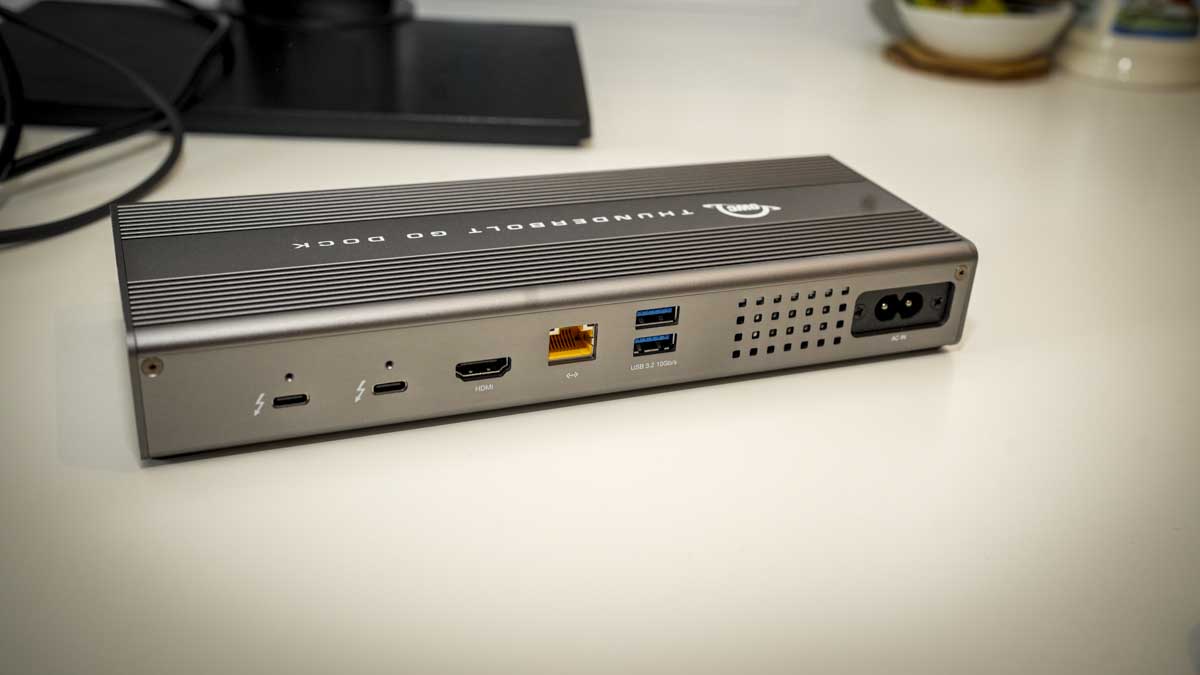
- How much does it cost? $299
- When is it out? Available now
- Where can you get it? You can get it from OWC and Amazon
At $299, the OWC Thunderbolt Go Dock is well priced considering its features and robust build, making it an attractive choice for high-end Thunderbolt 4 docks. The dock is available for purchase through the OWC website, Adorama B&H Photo, and many other online retailers.
- Value: 5 / 5
OWC Thunderbolt Go Dock: Specifications
| Model: | OWC Thunderbolt Go Dock |
| Compatibility: | Supports Windows 7/8/10 macOS 10.8 or later |
| Video Output: | HDMI 2.1 |
| USB Ports: | 2 x Thunderbolt 4 (USB-C) Ports, USB 3.2 Gen 2 Type-C Port up to 10Gb/s (All Support Video out), Thunderbolt 4 (USB-C) up to 40 Gb/s (Computer connection), 2 x USB 3.2 Gen 2 Type-A Ports up to 10Gb/s, USB 2.0 Port |
| Audio: | 1 x Audio/Mic Port 3.5mm |
| Networking: | 1 x 2.5G Ethernet Port |
| Memory Card Slots: | 1 x SD/MicroSD V4.0 Card Slot |
| Power Delivery: | Up to 90W via USB-C PD (Power Delivery) 3.0 |
| Power Supply: | 100~240V, 50~60Hz, 1.5A |
| Dimensions: | 360mm x 241mm x 92mm (L x W x H) |
| Weight: | 949 |
| Other Features: | Supports up to two displays at 4K@60Hz / 6K@60Hz, one 8K display at 120Hz |
OWC Thunderbolt Go Dock: Design
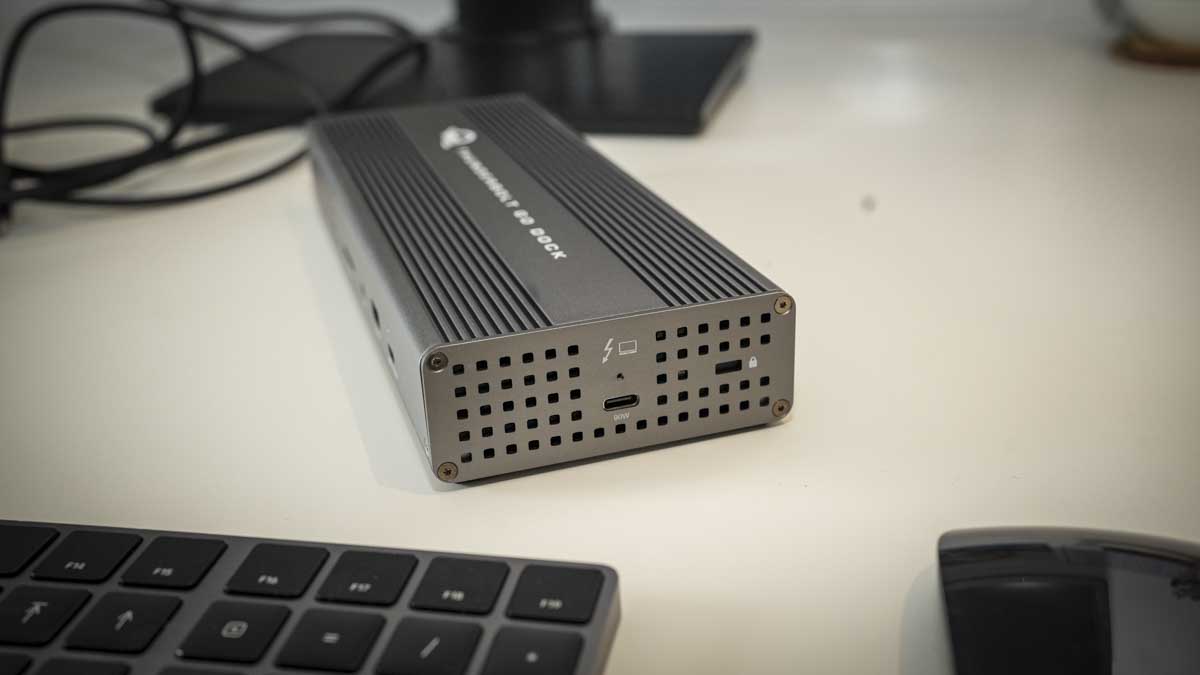
- Single power cord
- Wealth of ports
- Robust portable design
The OWC Thunderbolt Go Dock's design breaks away from your usual sleek and stylish desktop docking station and instead goes for a more industrial and robust design that is no less appealing. The all-metal construction gives it a high-quality feel, and it's extremely well-finished. The design is reminiscent of professional broadcast and imaging equipment, with a robust, no-fuss quality that reflects its intended use.
While the dock is intended to be portable, it still requires mains AC power, unlike many light desktop docking stations that rely on bus power. Portable power, however, is not an issue with the likes of the Bluetti AC200, which is a popular on-site power station for video and photoshoots in the field. Power is supplied through a single standard C7 cable, eliminating the need for an external power supply and making it neat to pack away when you need to move your kit around. The power lead is a C7, more commonly known as a figure of 8 or shotgun connector, so if you run out of the door without one, then they're not too difficult or expensive to replace.
When it comes to size and weight, it is larger than your standard portable bus-powered docking station or hub, measuring 3.6 x 24.1 x 9.2 cm and weighing 949g. However, the docks' no-fuss rectangular shape, and the absence of an adapter means that it easily slips into a backpack pocket or Peli case for transport.
A close look at the design shows all ports and connections nicely laid out on the front, including an SD memory card slot supporting UHS-II, a 3.5mm headphone jack, and a USB 2.0 and USB 3.2 Gen 2 (10Gb/s) port. These provide access to both Type-A and Type-C USB connections directly on the front of the device. These can be used to plug in OWC CFExpress card readers and Envoy SSDs.
Flipping around to the back, there are two Thunderbolt 4 ports and an HDMI 2.1 port, which supports up to 8K at 60Hz or 4K at 120Hz. This is fully compatible with M-Series MacBook Pros. Next to this is a fast 2.5Gb Ethernet port. Finally, there are two USB 3.2 Type-A ports, each delivering 10Gb/s, an AC input for the standard C7 type cable, a security slot. On the side of the box is a third Thunderbolt 4 port, which connects directly to your computer and provides up to 90W of power delivery. The PD will enable the dock to power most laptops, enabling you to leave your computer's power supply at home and reducing the number of cables and accessories you need to carry.
The OWC Thunderbolt Go Dock offers all the features of a standard high-performance desktop dock in an ultra-robust and portable design that provides balanced performance in both studio and fieldwork.
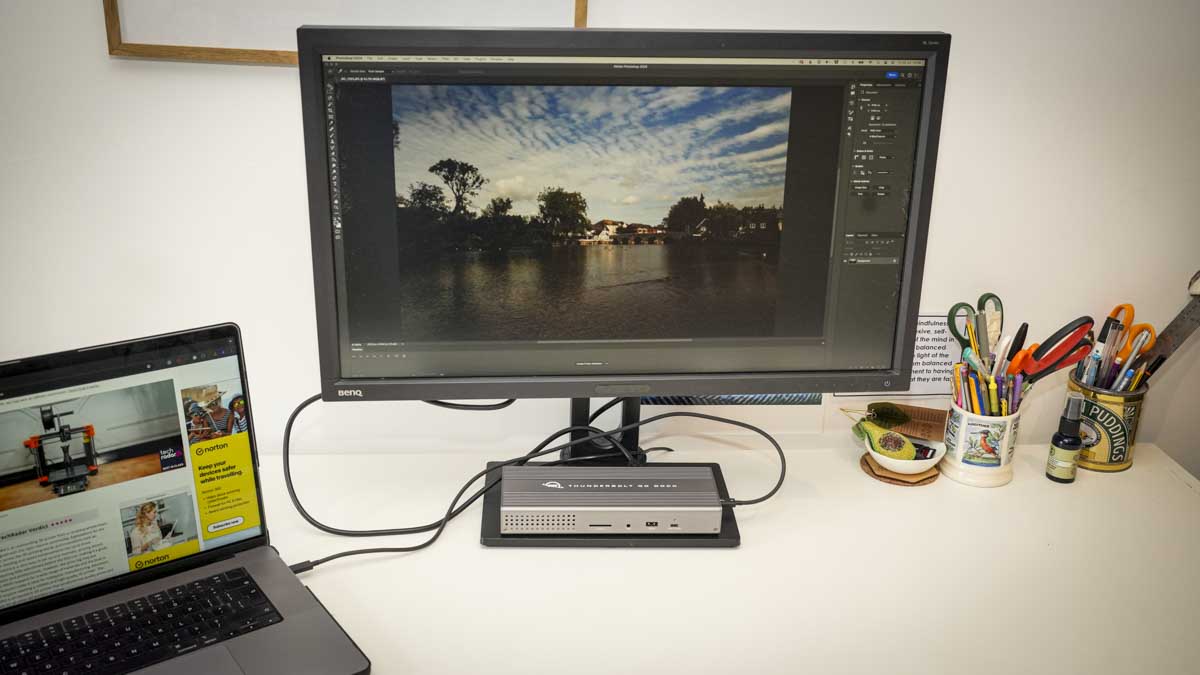
- Design: 5 / 5
OWC Thunderbolt Go Dock: Features
Most docking stations are designed for the modern office, with a sleek design and the latest connectivity options that will satisfy the needs of the majority of users. However, the OWC Thunderbolt Go Dock has been designed for use by creatives who might find themselves working as much away from the studio as in it, so require a robust and portable dock that doesn't pull back on features. The dock's all-metal, robust build is in line with the high quality that you find with most broadcast equipment and is designed for on-set use as well as studio. While it still requires mains power, it is ultra-portable and far more durable than your average computer docking station.
The full metal casing not only allows it to withstand transportation and a knock or two, but in use, it maximizes airflow through the dock, ensuring it remains cool when connected to networks, SSDs, memory card readers, computers, and other accessories. The fin design on the top of the case resembles a heat sink and further helps to dissipate heat by maximising surface area as the docking station manages multiple device connections.
The idea behind any docking station is to enable you to connect one cable to your computer, with all other connections running through the dock. This makes it easy to quickly disconnect and reconnect all accessories and monitors when moving your computer around. With the OWC Thunderbolt Go Dock, this process is highly refined, not only through the physical hardware ports but also with software support, such as the OWC Dock Ejector. This software adds a software eject button on your computer, allowing you to quickly and safely disconnect devices connected through the dock, including SSDs and monitors.
On the front and back of the dock, there are a wide range of ports that enable you to connect to multiple accessories. A handy feature of many docks is the PD power that enables you to supply power to your laptop as well as the connected devices; through the side port on the dock, PD power is supplied up to 90W, which is more than enough to charge your laptop be that an ASUS ProArt or MacBook Pro. For displays, you can connect one 8K display or one 4K display running at 120Hz. For production, where at least two monitors are often needed, you can connect up to two 4K 60Hz monitors using either the Thunderbolt 4 ports on the back or the Thunderbolt 4 and HDMI 2.1 port.
The dock enables you to maximize the use of ultrafast SSD drives such as the OWC Express 1M2 or the compact OWC Envoy SSD. You can also connect large desktop NAS solutions such as the OWC Jupiter, although again, they will also need their own AC power. With plenty of USB options around the dock, you can charge USB devices and accessories. As you'd expect, there is a 2.5Gb Ethernet port, which offers a fast network option, although, for video production, a 10GbE would have been nice to see
For photographers and videographers, the inclusion of an SD card slot of the UHS-II variety on the front makes it easy to download footage or photographs quickly. While it doesn't have a CFexpress Type A or Type B card slot directly, you can use one of the OWC 4.0 CF card readers via a Thunderbolt port for ultra-fast downloads. Using the OWC option also means that it will be fully compatible with the Dock Ejector and Innergize software solutions.
The dock also supports up to two Thunderbolt daisy chains, further increasing the number of devices you can connect to your computer.
For Windows users with an Intel Evo-certified laptop, the dock offers the Thunderbolt Share feature. This KVM (keyboard, video, and mouse) feature enables quick sharing of devices and content between two Thunderbolt computers from one Thunderbolt port; it's again worth noting that this feature is only accessible for laptops with Intel Evo certification.
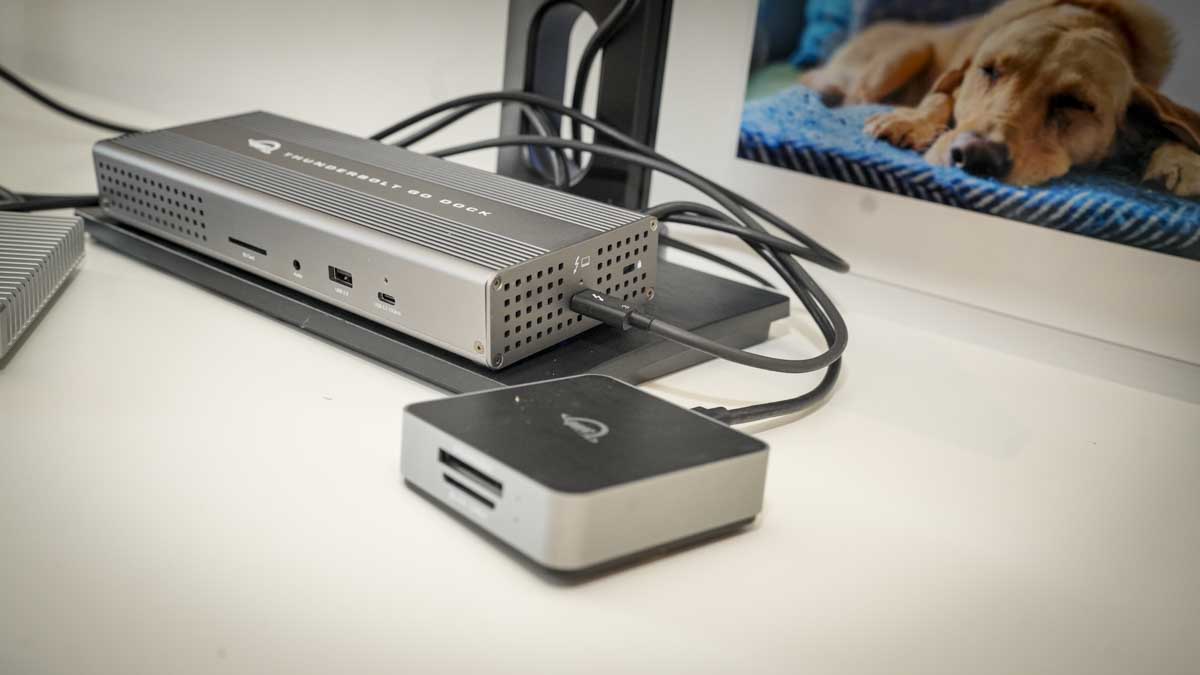
- Features: 4 / 5
OWC Thunderbolt Go Dock: Performance
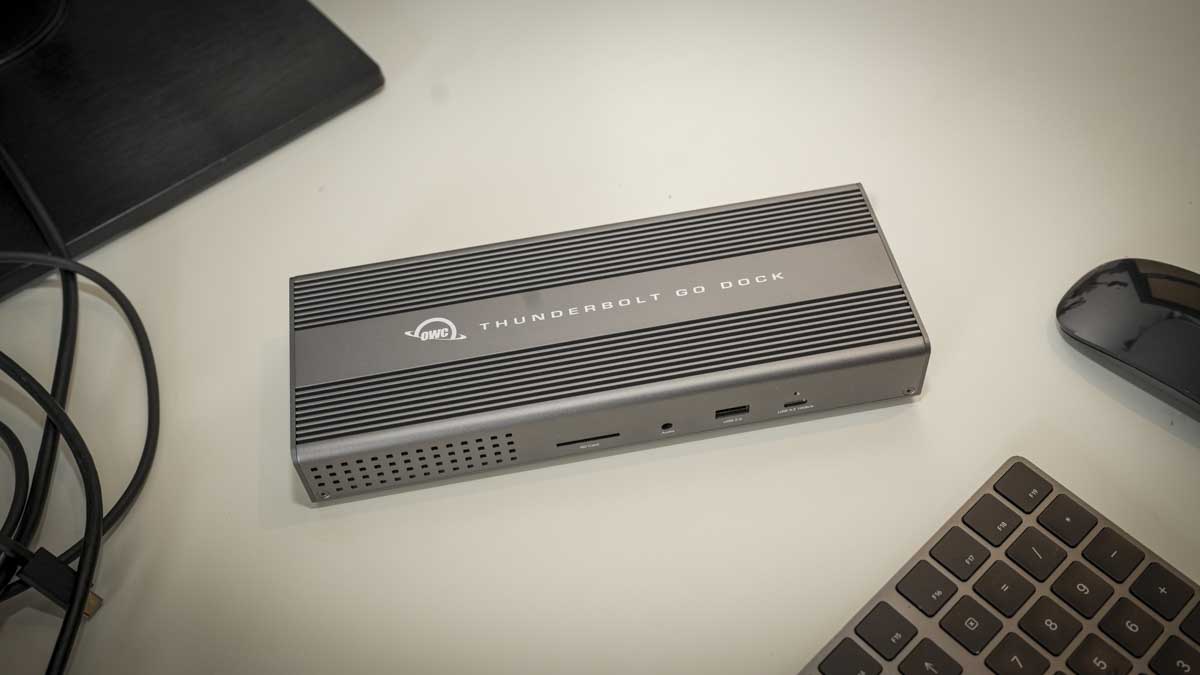
The OWC Thunderbolt Go Dock was tested on a MacBook Pro 16-inch M1 Max and an ASUS ProArt P16, with two 4K monitors running at 60Hz, a selection of OWC SSDs, and a CFexpress Type B card reader.
Starting with portability and connection, the Thunderbolt Go Dock's streamlined design means it is extremely easy to set up, especially with the MacBook Book Pro. Throughout the test, the dock was transported between several locations, including the home, studio, and office. When transporting the dock, the size and shape allowed it to easily slip into the front pocket of a camera backpack or Peli case along with the MacBook Pro and some other computing hardware. The AC power cable also fits in alongside, taking up minimal space and making it portable and easy to access as soon as we arrive on location.
Setting up the Thunderbolt Go Dock is straightforward: plugging into an AC mains socket in the studio or Bluetti AC200 portable power station in the field and then connecting by a single Thunderbolt cable to the MacBook Pro, supplying both data connection and power.
When testing the portablity, a smaller monitor was used in combination with the laptop screen. Files from an OWC Atlas CFexpress Type B card were downloaded to an OWC Envoy Pro FX SSD. Both devices were connected through the two spare Thunderbolt 4 ports on the back of the dock, enabling ultra-fast transfer speeds comparable to plugging directly into the MacBook Pro itself.
One early consideration is that it would be nice to have dual Thunderbolt 4 ports on the front rather than the USB 3.2 port. Keeping the SSD connected, a short 15-minute edit of a 4K video shot on the Canon EOS 5C was carried out in Final Cut Pro X. Again, the Thunderbolt Go Dock had absolutely no issues with the editing process, and the transfer speeds for the SSD remained identical to when the drive was plugged directly into the computer.
When used in the field, several design features stood out. The robust build meant that it could withstand a knock or two, and the weight, was actually beneficial, as it stayed put even with lots of people moving around and working on less than robust work surfaces.
When it came to the use of the front ports the quick accessability was great although an additional USB Type-C port would have been nice. The other factor was that while SD is by far the most common memory card format for the camera industry, CFexpress Type A and Type B are now more commonly used for video production. While you can plug in a CFexpress Type B reader, it would be nice to have a CFexpress Type B and SD card slot, especially considering that OWC's CFexpress Type A card is available with a Type B card adapter that can be used with the reader system.
In the field, the Thunderbolt Go Dock's abilities are unquestionable. Its speed and single power cable connection make it easy to use and highly portable. The ability to plug countless accessories into the range of 11 ports makes it versatile for any video production or photo shoot. Back in the studio, the dock can be quickly unpacked, and again, its robust build reassures you that it will be fine after transportation, which will appeal to many photographers and videographers who routinely work away.
The port selection on the back gives a good number of options for external monitors. With two 4K 60Hz monitors plugged into the USB Type-C ports, it was a simple plug-and-play process, with the arrangement quickly accessible through macOS display settings.
Using a selection of video and photography shoots, the dock was able to support all-day transfers with no slowdown in transfer rates, as multiple SSDs and CFexpress card readers were connected. While the casing became warm to the touch, it never became hot. Testing the UHS-II SD card slot showed that transfer speeds were exceptionally good, comparable to those of the internal SD card reader on the MacBook Pro.
The Thunderbolt Go Dock's overall performance was excellent. The only real issue was the ability to connect only two monitors rather than three. However, using two monitors still makes a huge difference to the amount of workspace available. The other issue was the limited 2.5Gb network connection, which, for video editing, we would have expected to have been at least 5Gb or preferably 10Gb.
One feature that really stands out and sets the Thunderbolt Go Dock apart from other Docks is the software extras OWC has created to streamline the workflow process. The OWC Dock Ejector is probably one of the greatest innovations for any docking system, as it quickly enables you to eject all devices from the dock with one click. This means that if you have multiple SSDs and card readers connected to the dock, you can eject them all at once rather than individually.
The other software feature that is well worth mentioning is Innergize, which is useful if you use other OWC products. It maintains the health of your OWC Atlas memory cards. It essentially enables you to check their health, sanitize them to reset them back to factory conditions, and perform firmware upgrades, which can dramatically improve speed, as seen with Atlas cards in the past.
While it's a shame there are no CFexpress card slots built-in and no Thunderbolt 4 port on the front of the dock or the ability to connect three monitors, what the Thunderbolt Go Dock does offer is extremely high-end.
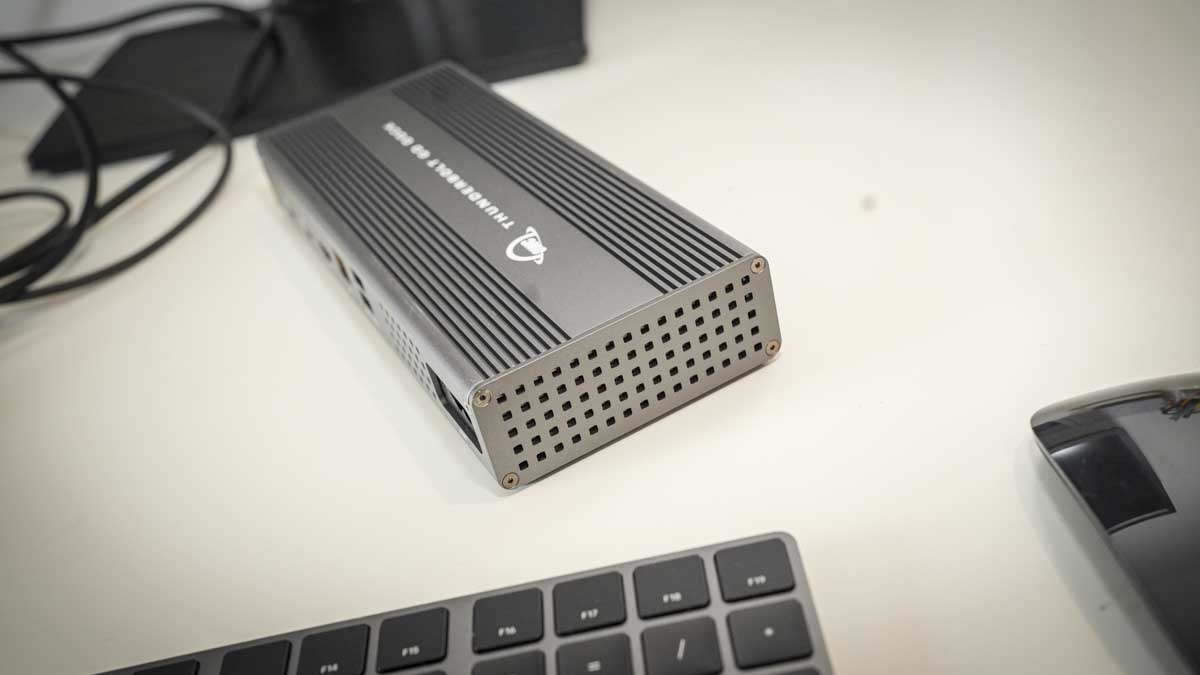
- Performance: 4.5 / 5
OWC Thunderbolt Go Dock: Final verdict
The OWC Thunderbolt Go Dock is a superb docking solution for videographers and photographers both in the studio and for field use. Its robust design and build mean it can be easily popped into a backpack or Peli case and will survive the rigours of on-site production or photo shoots. The metal casing looks great and is in line with broadcast equipment. The durable metal casing helps to ensure that it remains cool during heavy data transfer, which is common with video and image files.
While it is a shame that there are no Thunderbolt 4 ports on the front, there is a USB Type-C port and an SD card slot; however, it lacks a CFexpress Type B slot. The dock includes three Thunderbolt ports, one of them being used for the computer connection. The 4th USB-C port located at the front is USB 3.2 10Gbps.
The HDMI 2.1 rather than 2.0, which enables connection to larger monitors running 4K at 120Hz as well as the 8K at 60Hz.
The 2.5Gb Ethernet connection does provide a fast network connection, which will suffice for most users; however, it would have been nice to have seen a 5Gb or 10Gb option.
Overall, as a docking station that can be used in the studio or the field (as long as AC power is available), there is no other competitor for the Thunderbolt Go Dock when it comes to performance.
Should you buy the OWC Thunderbolt Go Dock?
| Value | Excellent value for professionals needing robust and portable docking. | 5 / 5 |
| Design | High-quality, durable metal build with a practical layout. | 5 / 5 |
| Features | Comprehensive port selection but lacks a third monitor connection. | 4 / 5 |
| Performance | Exceptional performance with ultra-fast transfer speeds and reliability. | 4.5 / 5 |
| Overall | Highly recommended for versatile, high-performance docking needs. | 4.5 / 5 |

Buy it if...
You Need a Portable and Durable Docking Solution:
The OWC Thunderbolt Go Dock's robust build and compact design make it perfect for professionals who need a reliable and portable docking station that can withstand field conditions.
You Require Fast Data Transfer and High Connectivity:
With multiple Thunderbolt 4 ports, HDMI 2.1, and 2.5Gb Ethernet, this dock offers ultra-fast data transfer speeds and extensive connectivity options, ideal for demanding workflows.
Don't buy it if...
You Need More Than Two Monitors:
If your setup requires connecting more than two monitors, the OWC Thunderbolt Go Dock might need to be increased, as it only supports up to two 4K or 6K monitors at 60Hz.
You Require Built-in CFexpress Card Slots:
For professionals who frequently use CFexpress cards, the lack of built-in CFexpress Type B slots may be a drawback, requiring additional card readers for compatibility.
For more extras for your set-up, we reviewed the best MacBook Pro accessories
